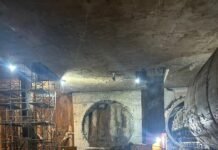Press release ( Metro Rail News): This release from NHSRCL represents the core idea of the bullet train, expected to be completed by 2026. The bullet train stations are to be designed in a way to improve accessibility and boost economic activities around stations. Bullet train stations serve as a doorway to a contemporary lifestyle. Every stop along the Mumbai-Ahemdabad Bullet Train track will be designed to capture the essence of the city it passes through. This will foster a sense of ownership over India’s first high-speed system and establish an immediate relationship with the local population.
By integrating with other modes like rail, metro, buses, taxis, and automobiles, the stations on the alignment will be designed as a transportation centre for a smooth travel experience. This will allow for quicker and easier connectivity to and from the station. By reducing journey times, improving accessibility, and encouraging the use of public transit, such an interface will lessen traffic and pollution in the cities.
Authorities Involved
Under the Mumbai Ahmedabad High-Speed Rail project (SMART), the program aims to introduce world-class station area development techniques in partnership with the Ministry of Housing and Urban Affairs, the Ministry of Railways, the Governments of Gujarat and Maharashtra, and the Japan International Cooperation Agency (JICA), which brings decades of experience from similar successful projects in Japan.
One of JICA’s responsibilities is to provide technical advice and experience to guarantee that the TOD plans adhere to international best practices.
Four stations have been shortlisted by the City & State authorities:
- Sabarmati and Surat in Gujarat
- Virar and Thane in Maharashtra
TOD under Bullet train project
The surrounding regions of bullet train stations are intended to be developed in compliance with TOD (Transit Oriented Development) rules to improve passengers’ and stakeholders’ accessibility and convenience as well as to encourage economic activity around the stations.
Benefits of TOD:
1. Improved Accessibility and Reduced Congestion. The project will streamline access to the stations, offering passengers a smoother transit experience.
2. Mix use development around HSR stations at a walkable distance by developing Key Infrastructure such as corporate offices, hotels, educational institutions, and healthcare facilities around the station areas, creating a holistic urban ecosystem
3. Boost to Local Economy: The TOD initiative is expected to foster commercial activities around the stations, benefitting local businesses and contributing to the regional economy
4. Revenue Generation through Land Value Capture: The development Initiatives can be supported by Urban Planning tools such as the introduction of premium FSI/FAR Transfer of Development Rights (TDR) etc.
5. Sustainable Urban Growth: The project will promote the surrounding cities as liveable, sustainable urban centres, attracting investment and improving the quality of life for residents.
The TOD initiative is planned to be implemented in a phased manner, ensuring long-term sustainability and scalability. The project will cater to both immediate needs at the station level and broader regional development in the future.
Additional information:
| Area | Description | Action/Planning |
| Area 1 | Immediate surroundings of Bullet Train station, Pick & Drop off, Parking, development Passenger Plaza | Multi-model integration (MMI) schemes for all stations in close coordination with different state planning authorities to ensure smooth integration with the existing infrastructure of Stage 1 is already completed |
| Area 2 | Up to 200-300 m around the station building including facilities for passengers. | The area around the station will be developed by various city authorities under the Gujarat and Maharashtra Governments This may require the incorporation of a station arca development plan in the Master Plan of the city, Development Plan and local plans. Amendment or substantive change in the policy framework such as change of bylaws, development controls, amendment of Floor Area Ration (FAR/PSI) etc. Widening of existing roads and correction in road geometry. |
| Area 3 | Up to 500-800m around the Bullet Train station building including medium to long term development. | Influence areas beyond Area 2 are to be developed based on the city’s vision of creating its unique identity utilising the presence of HSR connectivity. This may include Urban Planning tools such as change in Land use, transfer of Development rights (TDR) etc. This area shall be developed by city authorities considering a period beyond 10 years. |
Mumbai Ahmedabad High Speed Rail (MAHSR) Project
| Total length | 508 km (Gujarat: 352 km, Maharashtra: 156 km) |
| Total stations | 12 ( Mumbai, Thane, Virar, Lotsar, Vapi, Bilimona, surat,Bharuch, Vadodara, Anand/Nadiad, Ahmedabad and Sabarmati) |

Current Status (as on 21 Oct 2024)
- The entire land (1389.5 Ha) for the Project has been acquired.
- All Civil tenders and depot tenders for the Project and Track tender for the Gujarat portion have been awarded.
- Viaduct construction is in full swing.
- Pier works: 8 km
- Viaduct construction: 222 km
- Bridges on rivers: 11
- Erection of Steel bridges 5
- Work is progressing on all 12 Bullet Train stations.
- Installation of Noise Barriers is underway.
- Progress of 42.07 km of Track bed construction has been achieved so far.
- The work of a 21 km tunnel with a 7 km length passing through undersea has also started.
- The undersea tunnel is about 36 m below the ground with a diameter of 12.1 m to accommodate both UP and DN tracks of Bullet Trains in one tunnel Such big big-diameter undersea tunnel is being constructed first time in India. 10 km of Tunnel out of a total of 21 km is planned to be constructed using a Tunnel Boring Machine (TBM) and the remaining 5 km by the New Austrian Tunneling method (NATM). Slurry-type TBMs with cutter head diameter of 11.6 m are being procured keeping in mind the ground conditions and reliability. Works on three shafts for lowering and retrieval of TBMS are nearing completion. Further, the 194 m long Additionally Driven Intermediate Tunnel (ADIT) is already completed and tunnel boring through NATM has taken up three faces simultaneously to pace up the work.





